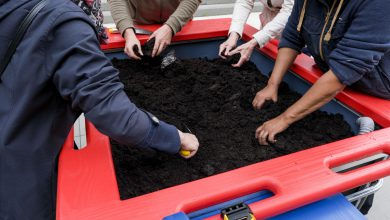
Why would anyone ever want to eat something called “nettle”? Well, because it’s delicious and nutritious! Our ancient ancestors knew the value of this unhappily named plant and you can still enjoy it today. This week a recipe for an ancient nettle pudding. For those unfamiliar with non-dessert pudding, it has the consistency of a dumpling and is often eaten with pieces of bread and the meat cooked alongside.
The stinging nettle is usually thought of as an annoying weed, but in reality it is much more. It is a member of the Urticaceae family, named after the Latin word uro, which means “to burn” (the fine hairs on the leaves and stems can evoke this feeling), and it can grow seven feet tall. Since ancient times, it has been used as a food source, medicine and even as a material for making fabrics.
In Denmark, a 2,800-year-old shroud, consisting of a “soft and shiny fabric,” was made from nettles instead of the more typical flax.[1] Interestingly, the use of the nettle in the production of the textile showed that this Bronze Age civilization was trading (the nettle is not native to this area) and that they were using wild plants in addition to domesticated plants.[2]
The nettle can not only be used tomake fabrics, but can also color them. Stinging nettle is rich in chlorophyll and can be used to produce a green dye that has been used for centuries. In World War II, the British government used green dye from nettles to camouflage army uniforms.
Stinging nettle has been valued for its medicinal uses for thousands of years. The Egyptians used an infusion of nettles for arthritis and lumbago.[4] The ancient Greeks believed that nettles could treat a wide range of ailments. Hippocrates wrote about 61 different treatments with nettles, including against bites and stings, and Galen, the Greek physician, wrote in his book The Simplicubus that it could be used as “a diuretic and laxative, for dog bites, gangrenous wounds, swellings, nosebleeds, excessive menstruation, spleen-related diseases, pleurisy, pneumonia, asthma, tinea and mouth ulcers.” The Romans used it to treat muscle pain and sciatica. They also beat their bodies with bunches of nettles to stimulate blood flow and circulation. This practice was popular among soldiers traveling from the warmer Roman climate to the colder climate of Britain. This is just a small sample of the numerous uses of nettle over the centuries.
Finally, the nettle has long been an important food source and was highly valued by ancient cultures. Its use as food has always been closely linked to its medicinal value. It was often eaten in the spring because it was believed to promote circulation and restore warmth to the body after the cold winter months. Generally, the younger plants were chosen as food because they are less bitter, but the more mature leaves can be cooked until suitable for consumption. The Romans cooked nettles together with meat to make it more tender. Europeans used them in soups and puddings like the one below. In fact, the recipe below was named Britain’s oldest recipe in 2007 and is thought to date from around 6,000 B.C. Chr. are.
Those who think of old-fashioned English cooking probably think of roast beef or steak and kidney pie. But nettle pudding makes those dishes look like young fun eyes. The 6,000 BC creation was named Britain’s oldest recipe in 2007.
It was a staple of Stone Age man, who made it by mixing nettles and other leaves such as dandelion and sorrel with barley flour, salt and water. Almost as old are smoky stew, made from bacon and smoked fish, and meat pudding, a precursor to haggis and sausage.
Roasted hedgehog was also a firm favorite some 8,000 years ago, it turns out. Served with a sauce of wild duck or cinnamon, hedgehog was the origin of the rich, as its prickly nature meant that only the most adventurous cooks would not avoid it.
Barley bread was popular from about 5,000 BC, while potage, or stew of meat and vegetables, became part of the diet of ancient Britons 3,000 years later.
With the arrival of the Romans came the idea of using eggs to mix and bind food, rather than simply eating it whole. Cracking the egg led to custards, pies and pastries, including the original mince pie.
Unlike the sweet versions preferred by 21st-century Britons, the first mince pie contained meat. It also contained fruit, while alcohol and spices were used to preserve the mixture.
The recipes were initially passed down orally, but from Roman times they were written down and many of them became part of today’s diet.
But while pies, stews and dumplings are still popular today, other ancient foods have disappeared from most menus. These include garum and liquamen. These pungent pastes and sauces, made from fish guts and heads, were made by the Romans from the 1st century AD to flavor dishes.
Dr. Ruth Fairchild, who spoke with food experts and archaeologists to compile the list of Britain’s oldest recipes, said we can learn a lot from the way our ancestors handled food.
Food waste is huge these days. A third of the food in our refrigerators is thrown away each week without being eaten. But they would have wasted nothing, even hooves would have been used for something. They had to eat what was grown within a radius of several kilometers, because it would take so long to gather everything, and even gathering water would have been a bit of an ordeal.
NETTLE PUDDING (an 8,000-year-old recipe!)
Ingredients
- 1 bunch of sorrel
- 1 bunch of watercress
- 1 bunch of dandelion leaves
- 2 bunches of young nettle leaves
- Some chives
- 1 cup of barley flour
- 1 teaspoon of salt
Instructions
Chop the spices and mix in the barley flour and salt. Add enough water to bind and place in the center of a linen or muslin cloth.
Tie the cloth tightly and place it in a pan with simmering venison or wild boar meat (a pork steak is also good) or try without. Make sure the string is long enough to pull the pudding out of the pan.
Cook the pudding until the meat is tender (at least two hours).
Let the pudding cool slightly, remove the muslin cloth and then cut the pudding into thick slices with a knife.
Serve the pudding with pieces of barley bread.
Reprinted from https://antiquitynow.org/2015/01/07/bon-appetit-wednesday-ancient-nettle-pudding-britains-oldest-recipe/





